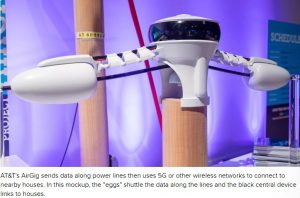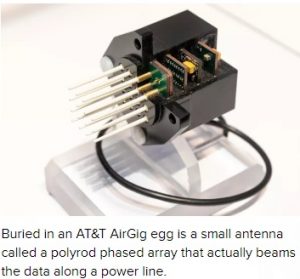Source: AT&T plans AirGig boost for rural, suburban broadband in 2021 – CNET
AT&T hopes its AirGig technology for piggybacking high-speed data links on power lines will arrive in 2021, potentially improving broadband in areas where it’s not economical to lay fiber-optic cables.
AirGig doesn’t connect directly to houses. Instead, it sends data hopping along from power pole to power pole so it can traverse relatively long distances. For that final communication link to a house, AT&T will use more conventional wireless equipment like 5G mobile networks.
“We’re aiming to be ready to deploy it commercially in the 2021 timeframe,” said Mark Evans, a director on AT&T’s AirGig team, at the AT&T Spark event Monday in San Francisco. The timing could change, he cautioned: “It could be things go swimmingly and we could move that date in.”
AirGig has the potential to help solve a thorny problem for the tech industry: making sure it’s not just people in densely populated areas like New York City and San Francisco who get the latest services. Rural broadband is often an oxymoron, denying people outside cities and denser suburbs access to next-gen services in video streaming, e-commerce and online learning. AirGig won’t reach everywhere, but it could help.
AT&T unveiled AirGig in 2016 and began testing it with Georgia Power in 2017. Now AT&T has started working with equipment manufacturers to build more refined hardware for a new round of AirGig testing most likely in 2019, said Gordon Mansfield, AT&T’s vice president of converged access and devices.
Easy to install
A key part of the AirGig technology is that it’s not complicated to install. Antenna modules — AT&T calls them eggs — clamp in pairs on the power line extending each direction from the power pole. The medium-voltage power line itself powers the eggs inductively, similar to how wireless charging pads for phones work, so no specific power connection is required.
The eggs configure themselves automatically, and the early test showed it takes people 10 minutes to hook up to the network, said AT&T Chief Technology Officer Andre Fuetsch.
The data is sent directly along the power line itself. The wire acts as a waveguide that channels the signal and improves the transmission quality compared to traveling through plain old air, Evans said.
“The signal energy clings like a glow to this wire,” said AT&T radio technology engineer Peter Wolniansky in an onstage demonstration. Electromagnetic physics governs how, he said: “It’s bound by Maxwell’s equations to stick to this wire.”
Data speeds of 90 gigabits per second
His demonstration showed data capacity of 90 gigabits per second — enough to stream thousands of HD-quality movies at the same time, once distributed to houses. “You can serve hundreds if not thousands of homes with this,” Wolniansky said.


